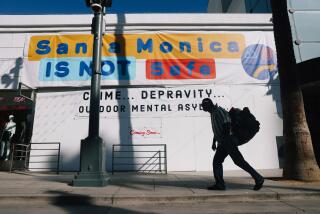Forecast Remains Cloudy and Cold for County’s Homeless
- Share via
El Nino may prove to be something of a foul-weather friend to the homeless this year and the focus of anxiety for homeless advocates.
In October, the prospect of the cold, wet winter was one of the forces that prodded Gov. Pete Wilson to relent from his veto of the 10-year-old program that allows National Guard armories to open as cold-weather emergency homeless shelters during the coldest months.
Social-service workers serving the estimated 12,000 to 15,000 homeless in Orange County hope that the driving rains and floods will cause people with roofs over their heads to imagine the plight of the homeless.
But the current emergency programs, like the rain itself, will not last long, although the aftereffects of the destruction will.
Legislation extending the armory program also forces each county to form a commission charged with exploring alternative shelters, with the reports due to the state in June. Otherwise, Wilson said, counties that do not comply could be cut off from that aid.
Santa Ana’s armory opened Monday with its first small crisis--no heat. And when the Fullerton Armory opens today, the homeless will be sleeping on mats since the emergency cots have deteriorated beyond repair.
*
But those are relatively small concerns compared with the prospect of having no armories to open at all within a year or two, said Maria Mendoza, the former homeless coordinator for the county who has come out of retirement to work on the commission.
She and the 19 other commission members will be faced with an issue that never seems to get better and which has wearied workers, churches and a vast segment of the public.
“There’s a lot of disenchantment,” Mendoza said. “A lot of people who have worked on the homeless issue have moved on to other things that are more sexy; a lot of times it’s something that’s more acceptable.”
Dolores Barrett, social services director for the county’s Salvation Army, said she has seen the homeless issue go through many transformations during the 20 years she has dealt with the issue.
“Six years ago, homelessness was a popular issue,” she said. “It’s a much more punitive attitude now. We’re a society that runs through social issues. We’re the video generation. We can’t keep our focus more than 20 minutes. That’s just who Americans are.”
Orange County presents its own particular challenge because the 31 municipalities each have their own set of roadblocks. Coordination is a serious problem.
And both the state and federal governments have made it clear that homelessness is going to be a community problem in the very near future. Andrew Cuomo, secretary of Housing and Urban Development, held a video conference with Southern Californian advocates just last week to drive home that point.
Barrett, like her colleagues in other agencies, said she is optimistic that the communities will come through. After all, she said, some 800 people volunteered last year to work at the armory.
“We need to figure out a strategy, go after that program expansion, and we need support,” she said. “We need to go to the media when it’s time. We need to go to political people when it’s time. That’s how we got the armory thing going.”
Advocates who deal with government programs--the armory beds are funded with county and federal emergency funds--said the controversy this past year about Southern Baptist Minister Wiley S. Drake’s church shelter was not entirely indicative of what is really going on with the homeless. He was convicted of misdemeanor violations of Buena Park’s city code this summer for sheltering the homeless on church grounds.
*
While the outcry from Drake’s neighbors about his shelter did illustrate community resistance, many have already ruled out churches as a solution to the problem. Most churches do not consider such aid to the homeless as their mission, and few have the space or funds to cope with the problem.
Jim Miller, who heads the Shelter for the Homeless in Midway City, among other projects, said the answer has to come from various levels of government and the private sector.
“I have the perfect answer,” Miller said. “I would like to see the federal government issue tax credits to businesses to provide this kind of emergency shelter. It can be done.”
As an example of good planning, Miller points to a men’s shelter he runs in Riverside that was put into an abandoned auto shop. Rather than putting the needy in the middle of neighborhoods, they could be put in more commercial districts, he said.
All agree that the cities and the county will have to form a regional plan and jointly finance the project. The cost of a year-round emergency shelter can be $300,000 per year or more.
“It’s a matter of political will,” Miller said. “Orange County is not prepared to deal with this. People like [the commission members] will start addressing it and make our needs known to the League of Cities and the Board of Supervisors. But without a plan, you can talk until you’re blue in the face and nothing will happen.”
More to Read
Sign up for Essential California
The most important California stories and recommendations in your inbox every morning.
You may occasionally receive promotional content from the Los Angeles Times.










